Self-Powered System Development with Organic Photovoltaic (OPV) for Energy Harvesting from Indoor Lighting
Abstract
1. Introduction
2. Energy Harvesting for Self-Powered Systems
2.1. Selection of the Bibliographic Portfolio
2.2. Systemic Analysis Bibliographic Portfolio
3. Hardware Development
4. Results
5. Discussion
6. Conclusions
Author Contributions
Funding
Data Availability Statement
Conflicts of Interest
References
- Sutikno, T.; Aprilianto, R.A.; Purnama, E.H.S. Application of non-isolated bidirectional DC–DC converters for renewable and sustainable energy systems: A Review. Clean Energy 2023, 7, 293–311. [Google Scholar] [CrossRef]
- Kaushalya, T.; Littow, M.; Virta, E.; Ruotsalainen, T.; Juuti, J.; Bai, E.Y. Evaluation of charging efficiency for power management integrated circuits and their compatibility with indoor light energy harvesting devices for IOT sensors. SSRN, 2023; preprint. [Google Scholar] [CrossRef]
- Mohamad-Saleh, W.-H.T.E.J. Critical review on interrelationship of electro-devices in PV solar systems with their evolution and future prospects for MPPT applications. Energies 2023, 16, 850. [Google Scholar] [CrossRef]
- Bito, J.; Hester, J.G.; Tentzeris, M.M. A fully autonomous ultra-low power hybrid RF/Photovoltaic energy harvesting system with −25 dbm sensitivity. In Proceedings of the 2017 IEEE Wireless Power Transfer Conference (WPTC), Taipei, Taiwan, 10–12 May 2017; pp. 1–4. [Google Scholar] [CrossRef]
- Jung, S.; Oh, J.; Yang, U.J.; Lee, S.M.; Lee, J.; Jeong, M.; Cho, Y.; Kim, S.; Baik, J.M.; Yang, C. 3D Cu ball-based hybrid triboelectric nanogenerator with non-fullerene organic photovoltaic cells for self-powering indoor electronics. Nano Energy 2020, 77, 105271. [Google Scholar] [CrossRef]
- Maciel, J.N.; Ledesma, J.J.G.; Ando Junior, O.H. Forecasting solar power output generation: A systematic review with the ProKnow-C. IEEE Lat. Am. Trans. 2021, 19, 612–624. [Google Scholar] [CrossRef]
- Ensslin, S.R.; Ensslin, L.; Yamakawa, E.K.; Nagaoka, M.P.T.; Aoki, A.R.; Siebert, L.C. Processo estruturado de revisão da literatura e análise bibliométrica sobre avaliação de desempenho de processos de implementação de eficiência energética. Rev. Bras. Energ. 2014, 20, 21–50. [Google Scholar]
- Sher, H.A.; Murtaza, A.F.; Noman, A.; Addoweesh, K.E.; Al-Haddad, K.; Chiaberge, M. A new sensorless hybrid mppt algorithm based on fractional short-circuit current measurement and P&O MPPT. IEEE Trans. Sustain. Energy 2015, 6, 1426–1434. [Google Scholar] [CrossRef]
- Tang, X.; Wang, X.; Cattley, R.; Gu, F.; Ball, E.A. Energy harvesting technologies for achieving self-powered wireless sensor networks in machine condition monitoring: A Review. Sensors 2018, 18, 4113. [Google Scholar] [CrossRef]
- Liu, R.; Takakuwa, M.; Li, A.; Inoue, D.; Hashizume, D.; Yu, K.; Umezu, S.; Fukuda, K.; Someya, T. An efficient ultra-flexible photo-charging system integrating organic photovoltaics and supercapacitors. Adv. Energy Mater. 2020, 10, 2000523. [Google Scholar] [CrossRef]
- Singh, R.; Shin, S.C.; Lee, H.; Kim, M.; Shim, J.W.; Cho, K.; Lee, J.J. ternary blend strategy for achieving high-efficiency organic photovoltaic devices for indoor applications. Chem. Eur. J. 2019, 25, 6154–6161. [Google Scholar] [CrossRef]
- Satharasinghe, A.; Hughes-Riley, T.; Dias, T. A review of solar energy harvesting electronic textiles. Sensors 2020, 20, 5938. [Google Scholar] [CrossRef]
- Tang, Y.; Li, X.; Lv, H.; Wang, W.; Zhi, C.; Li, E.H. Integration designs toward new-generation wearable energy supply-sensor systems for real-time health monitoring: A Minireview. InfoMat 2020, 2, 1109–1130. [Google Scholar] [CrossRef]
- Patra, A.; Namsheer, K.; Jose, J.R.; Sahoo, S.; Chakraborty, B.; Rout, C.S. Understanding the charge storage mechanism of supercapacitors: In situ/operando spectroscopic approaches and theoretical investigations. J. Mater. Chem. A 2021, 9, 25852–25891. [Google Scholar] [CrossRef]
- Grossi, M. Energy harvesting strategies for wireless sensor networks and mobile devices: A Review. Electronics 2021, 10, 661. [Google Scholar] [CrossRef]
- Takshi, A.; Aljafari, B.; Kareri, T.; Stefanakos, E. A critical review on the voltage requirement in hybrid cells with solar energy harvesting and energy storage capability. Batter. Supercaps 2021, 4, 252–267. [Google Scholar] [CrossRef]
- AAbdelnour, A.; Hallet, A.; Dkhil, S.B.; Pierron, P.; Kaddour, D.; Tedjini, S. Energy harvesting based on printed organic photovoltaic cells for RFID applications. In Proceedings of the 2019 IEEE International Conference on RFID Technology and Applications (Rfid-Ta), Pisa, Italy, 25–27 September 2019; pp. 110–112. [Google Scholar] [CrossRef]
- Batista, D.; Oliveira, L.B.; Paulino, N.; Carvalho, C.; Oliveira, J.P.; Farinhas, J.; Charas, A.; dos Santos, P.M. Combined organic photovoltaic cells and ultra low power CMOS circuit for indoor light energy harvesting. Sensors 2019, 19, 1803. [Google Scholar] [CrossRef]
- Nordin, N.A.; Ansari, M.N.M.; Nomanbhay, S.M.; Hamid, N.A.; Tan, N.M.; Yahya, Z.; Abdullah, I. Integrating photovoltaic (PV) solar cells and supercapacitors for sustainable energy devices: A Review. Energies 2021, 14, 7211. [Google Scholar] [CrossRef]
- Zhang, S.; Bristow, N.; David, T.W.; Elliott, F.; O’mahony, J.; Kettle, E.J. Development of an organic photovoltaic energy harvesting system for wireless sensor networks; application to autonomous building information management systems and optimisation of OPV module sizes for future applications. Sol. Energy Mater. Sol. Cells 2022, 236, 111550. [Google Scholar] [CrossRef]
- Takshi, A.; Tevi, T.; Rahimi, F. Organic photovoltaic devices with concurrent solar energy harvesting and charge storage capability. In Proceedings of the SPIE Optics + Photonics for Sustainable Energy, San Diego, CA, USA, 9–13 August 2015; Volume 9562. [Google Scholar] [CrossRef]
- Iwan, A.; Pellowski, W.; Bogdanowicz, K.A. Conversion of radiophotoluminescence irradiation into electricity in photovoltaic cells. A review of theoretical considerations and practical solutions. Energies 2021, 14, 6186. [Google Scholar] [CrossRef]
- Rahman, M.S.; Chakravarty, U.K. A hybrid energy harvesting system based on solar radiation and mechanical vibration. In Volume 1: Advances in Aerospace Technology; American Society of Mechanical Engineers: Pittsburgh, PA, USA, 2018; p. V001t03a017. [Google Scholar] [CrossRef]
- Lavanya, A.; Navamani, J.D.; Vijayakumar, K. Performance analysis of triple port dc-dc converter for energy harvesting systems. In Proceedings of the 11th National Conference on Mathematical Techniques and Applications, Chennai, India, 11–12 January 2019; p. 020012. [Google Scholar] [CrossRef]
- Lupo, D.; Keskinen, J.; Taavela, J.; Sirén, H.; Virtanen, J.; Mäntysalo, M. Flexible Temperature Logger Powered by Solar Cell and Supercapacitor. Poster Session Presented at innoLAE 2019, Cambridge, UK. 2019. Available online: https://researchportal.tuni.fi/en/publications/flexible-temperature-logger-powered-by-solar-cell-and-supercapaci (accessed on 20 May 2024).
- Biswas, S.; Lee, Y.; Kim, H. Micropower energy harvesting using high-efficiency indoor organic photovoltaics for self-powered sensor systems. J. Sens. Sci. Technol. 2021, 30, 364–368. [Google Scholar] [CrossRef]
- MArvani, M.; Keskinen, J.; Mansfeld, S.; Railanmaa, A.; Rokaya, C.; Lupo, D.; Hiltunen, A.; Vivo, P. Flexible energy supply for distributed electronics powered by organic solar cell and printed supercapacitor. In Proceedings of the 2020 IEEE 20th International Conference on Nanotechnology (IEEE-NANO), Montreal, QC, Canada, 29–31 July 2020; pp. 257–262. [Google Scholar] [CrossRef]
- Mashali, S.; Varjani, A.Y. Dual-Input, Single-Output Step-Up Dc/Dc power electronic interface for energy harvesting systems. In Proceedings of the 2023 14th Power Electronics, Drive Systems, and Technologies Conference (PEDSTC), Babol, Iran, 31 January–2 February 2023; pp. 1–5. [Google Scholar] [CrossRef]
- Oliveira, F.M.; Mariano, A.C.S.; Salvadori, F.; Ando Junior, O.H. Power management and power quality system applied in a single-phase nanogrid. Energies 2022, 15, 7121. [Google Scholar] [CrossRef]
- Kim, W.; Cho, K.; Lee, J.; Ko, D.; Jung, E.S. An indoor light-powered sensor system integrated with organic photovoltaics. Adv. Mater. Technol. 2023, 8, 2202040. [Google Scholar] [CrossRef]
- Dimitriev, O.P. Thermomechanical energy converters for harvesting thermal energy: A Review. J. Renew. Mater. 2023, 11, 1555–1600. [Google Scholar] [CrossRef]
- Poulek, V.; Dang, M.-Q.; Libra, M.; Beránek, V.; Safránková, J. PV panel with integrated lithium accumulators for BAPV applications—One year thermal evaluation. IEEE J. Photovolt. 2020, 10, 150–152. [Google Scholar] [CrossRef]
- Izidoro, C.L.; Chaves Filho, W.M.; Cavallari, M.R.; Ando Junior, O.H. Organic Photovoltaic (OPV) with electronic protection system: A systematic review. Braz. Arch. Biol. Technol. 2024, 67, e24230786. [Google Scholar] [CrossRef]
- Neves, L.A.; Leite, G.C.; by Paula Vieira, K.C.; MacKenzie, R.; Porto, M.P. Analysis of the performance of organic and inorganic photovoltaic cells under different air masses using numerical simulation. In Proceedings of the VIII Brazilian Congress of Solar Energy, Fortaleza, Brazil, 1–5 June 2020. [Google Scholar]
- Kjellby, R.A.; Johnsrud, T.E.; Loetveit, S.E.; Cenkeramaddi, L.R.; Hamid, M.; Beferull-Lozano, B. Self-Powered IoT device for indoor applications. In Proceedings of the 31th International Conference on VLSI Design and 17th International Conference on Embedded Systems, Pune, India, 6–10 January 2018. [Google Scholar]
- Foelkel, L. Energy Harvesting is not Fiction Anymore. In Proceedings of the 2nd PCNS, Bucharest, Romania, 10–13 September 2019. [Google Scholar]
- Ando Junior, O.H.; Chaves Filho, W.M.; Silva, E.A.D. System for Conditioning, Feeding, Storing, and Managing Energy for Sensors and/or Electronic Devices Self-Powered by Photovoltaic Cell; BR1020240088069; National Institute of Industrial Property (INPI): Rio de Janeiro, Brazil, 2024. [Google Scholar]


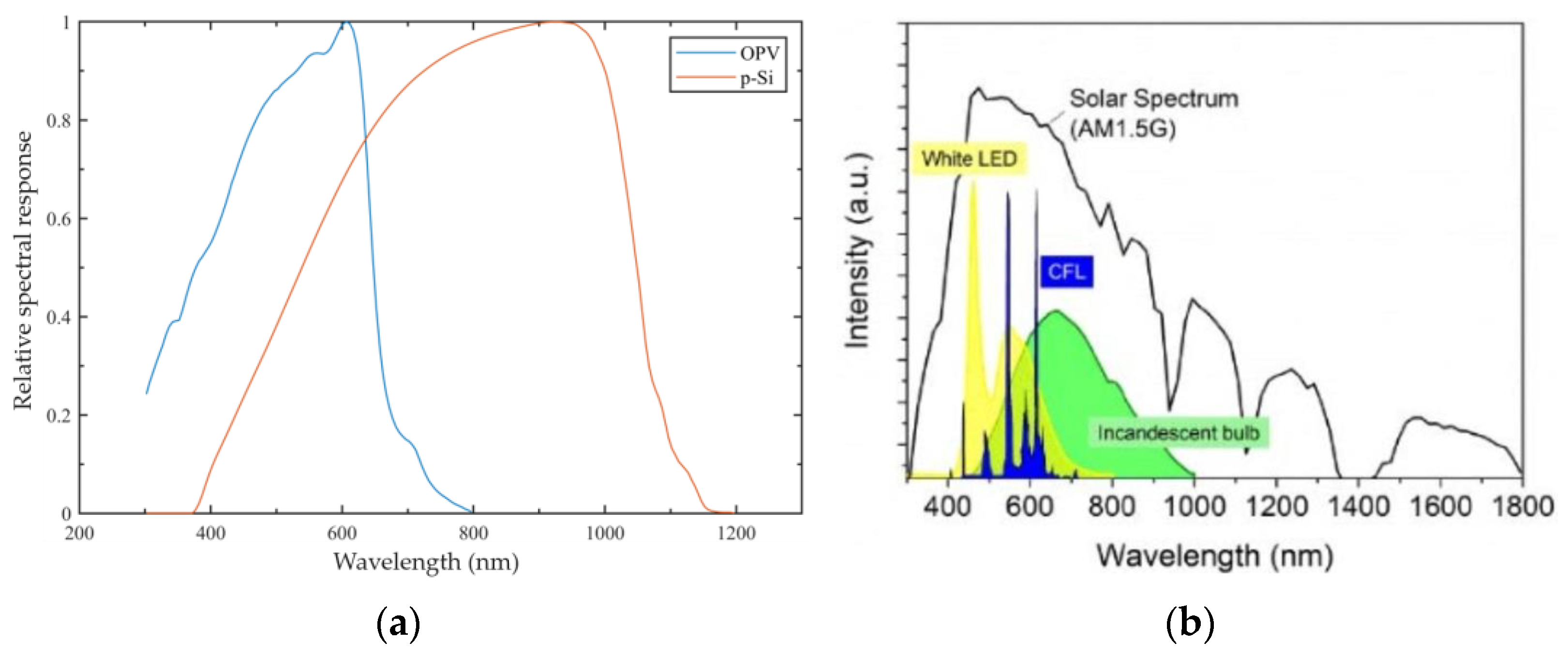



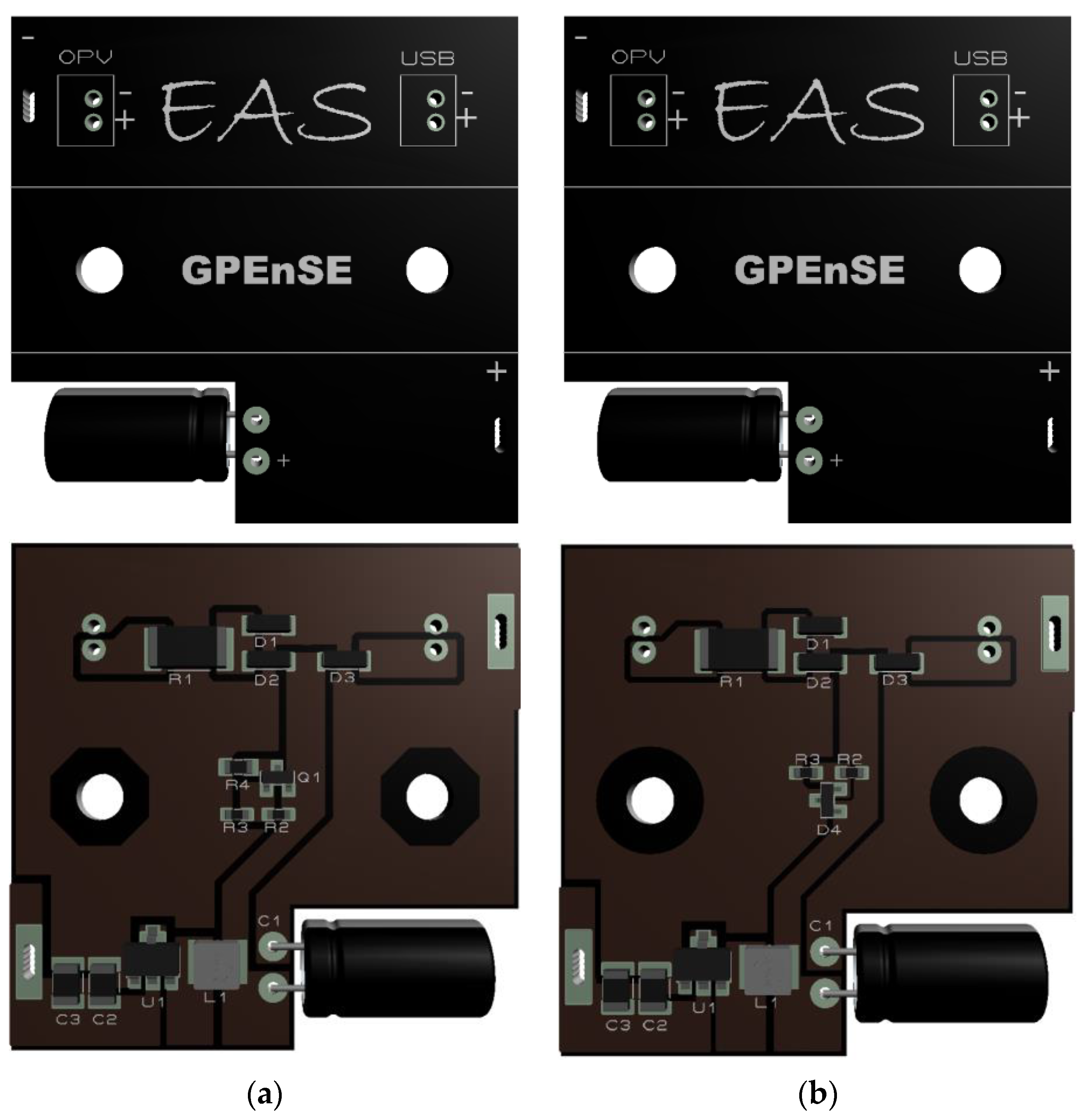
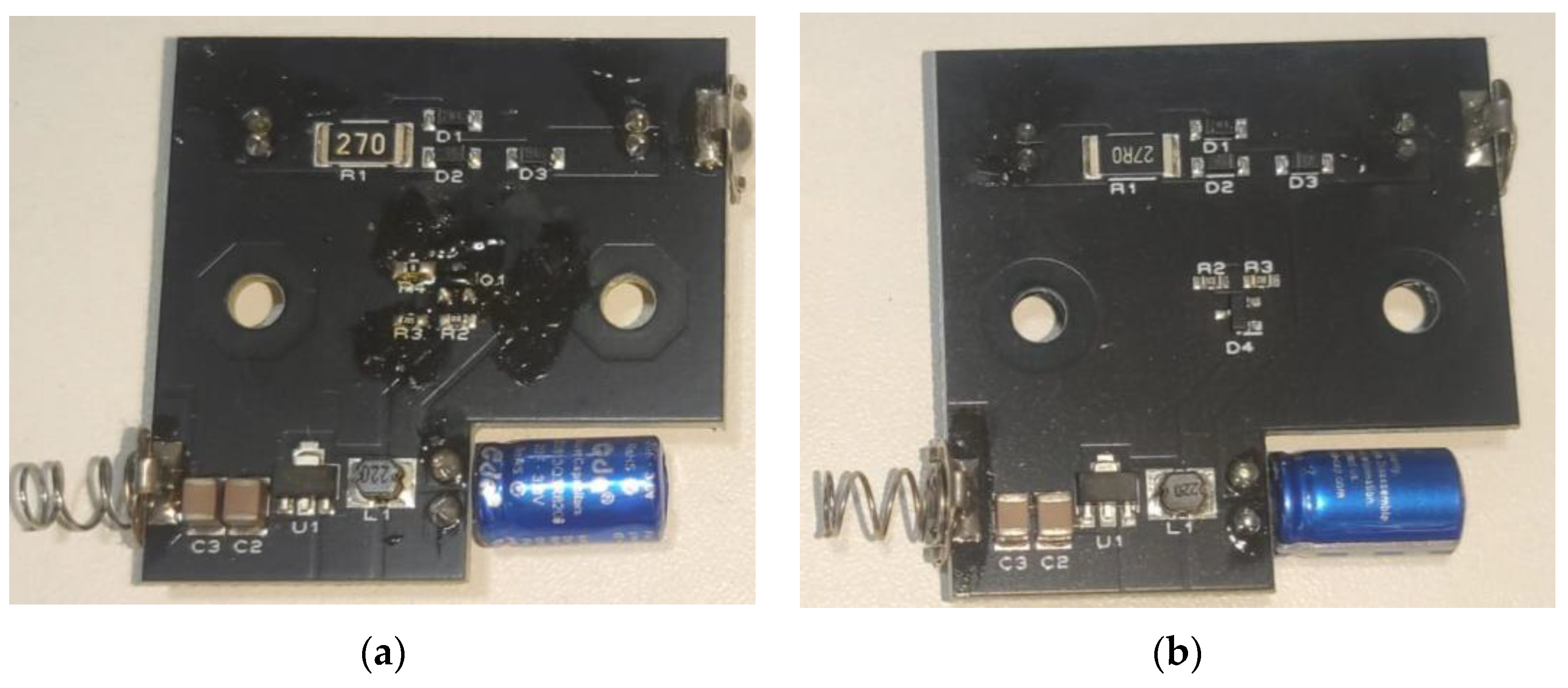
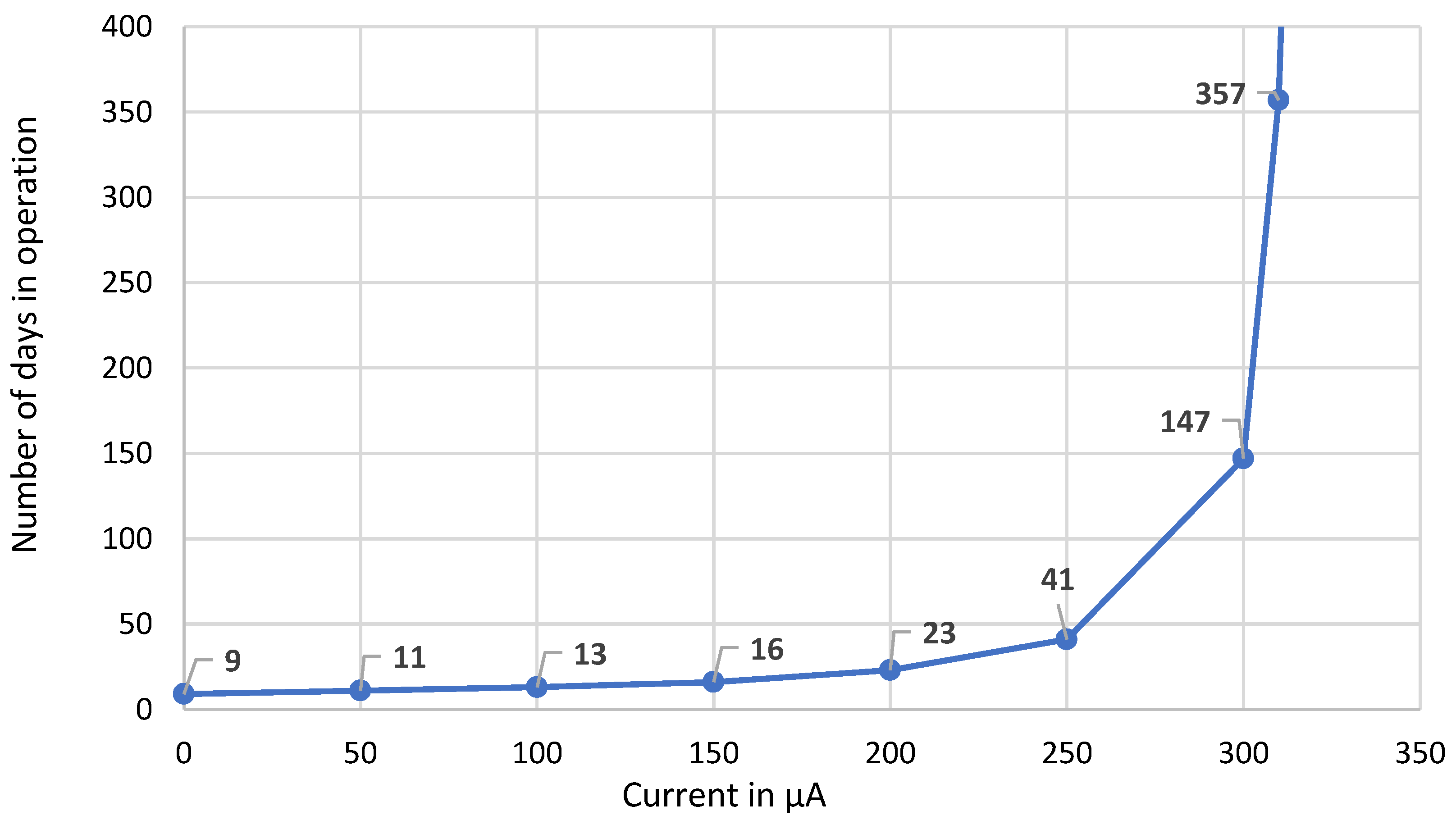
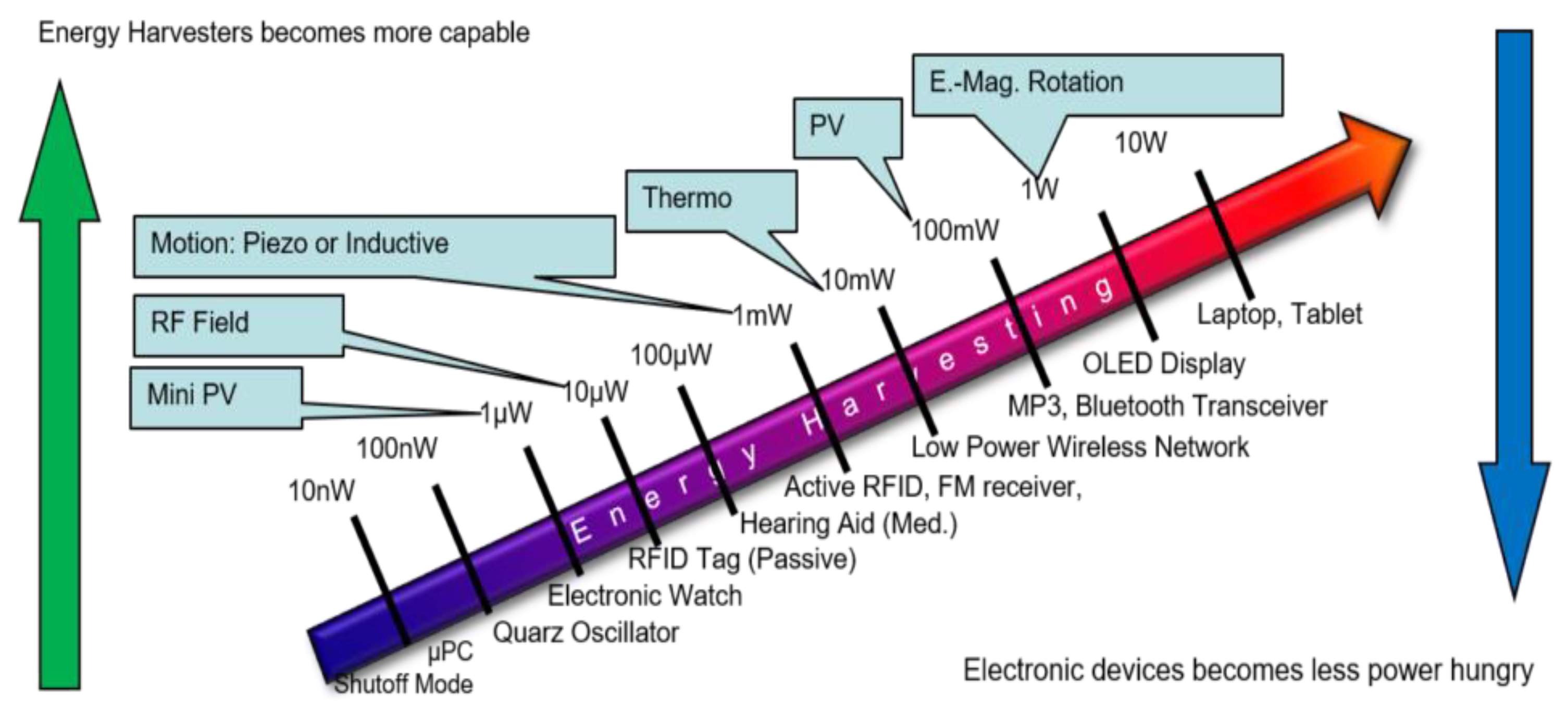

| Searched Combinations | Scopus | WoS | GS |
|---|---|---|---|
| “Organic Photovoltaic” AND “Supercapacitor” | 35 | 17 | 200 |
| “Organic Photovoltaic” AND “Buck-Boost” | 125 | 4 | 102 |
| “Organic Photovoltaic” AND “Self-Powered” | 80 | 15 | 200 |
| Total paper | 240 | 36 | 502 |
| Raw Paper Base | 778 | ||
| Repository C | Cit. | Ref. |
|---|---|---|
| A new senseless hybrid MPPT algorithm based on fractional short-circuit current measurement and P&O MPPT | 384 | [8] |
| Energy harvesting technologies for achieving self-powered wireless sensor networks in machine condition monitoring: A review | 181 | [9] |
| An efficient ultra-flexible photo-charging system integrating organic photovoltaics and supercapacitors | 61 | [10] |
| Ternary Blend Strategy for Achieving High-Efficiency Organic Photovoltaic Devices for Indoor Applications | 34 | [11] |
| A review of solar energy harvesting electronic textiles | 33 | [12] |
| Integration designs toward new-generation wearable energy supply-sensor systems for real-time health monitoring: A minireview | 32 | [13] |
| Understanding the charge storage mechanism of supercapacitors: in situ/operando spectroscopic approaches and theoretical investigations | 30 | [14] |
| Energy harvesting strategies for wireless sensor networks and mobile devices: A review. | 25 | [15] |
| A Critical Review On The Voltage Requirement In Hybrid Cells With Solar Energy Harvesting And Energy Storage Capability | 15 | [16] |
| Energy harvesting based on printed organic photovoltaic cells for RFID applications | 9 | [17] |
| Combined organic photovoltaic cells and ultra-low power CMOS circuit for indoor light energy harvesting | 9 | [18] |
| Integrating Photovoltaic (PV) solar cells and supercapacitors for sustainable energy devices: A review | 8 | [19] |
| A fully autonomous ultra-low power hybrid RF/photovoltaic energy harvesting system with −25 dBm sensitivity | 6 | [4] |
| Development of an organic photovoltaic energy harvesting system for wireless | 5 | [20] |
| Organic photovoltaic devices with concurrent solar energy harvesting and charge storage capability | 5 | [21] |
| Conversion of radiophotoluminescence irradiation into electricity in photovoltaic cells. A review of theoretical considerations and practical solutions | 4 | [22] |
| a hybrid energy harvesting system based on solar radiation and mechanical vibration | 3 | [23] |
| performance analysis of triple port DC–DC converter for energy harvesting systems | 2 | [24] |
| critical review on interrelationship of electro-devices in PV solar systems with their evolution and future prospects for MPPT applications | 2 | [3] |
| Flexible temperature logger powered by solar cell and supercapacitor | 1 | [25] |
| Micropower energy harvesting using high-efficiency indoor organic photovoltaics for self-powered sensor systems | 1 | [26] |
| Flexible energy supply for distributed electronics powered by organic solar cell and printed supercapacitor | 0 | [27] |
| Dual-Input, Single-Output Step-Up DC/DC power electronic interface for energy harvesting systems | 0 | [28] |
| Application of non-isolated bidirectional DC–DC converters for renewable and sustainable energy systems: a review | 0 | [1] |
| Evaluation of charging efficiency for power management integrated circuits and their compatibility with indoor light energy harvesting devices for IoT sensors | 0 | [2] |
| Power management and power quality system applied in a single-phase nanogrid | 0 | [29] |
| An indoor light-powered sensor system integrated with organic photovoltaics | 0 | [30] |
| Thermomechanical energy converters for harvesting thermal energy: A review | 0 | [31] |
| Voltage (V) | Current in R4 (µA) |
|---|---|
| 4.20 | 525.00 |
| 4.00 | 209.00 |
| 3.80 | 75.20 |
| 3.60 | 25.10 |
| 3.40 | 7.94 |
| 3.20 | 2.42 |
| 3.00 | 0.72 |
| 2.80 | 0.21 |
| 2.60 | 0.08 |
| Operating Specifications | Value |
|---|---|
| Maximum capacitor voltage [V]: | 4.20 |
| Minimum capacitor voltage [V]: | 2.50 |
| Maximum time without recharging [h]: | 72.00 |
| Charging time per day [h]: | 12.00 |
| Interval between recharging [h]: | 12.00 |
| Minimum charging current [µA]: | 350.00 |
| Capacitance [F]: | 20.00 |
| Standby load consumption [µA]: | 37.00 |
| Load consumption under normal conditions [mA] | 69.70 |
| Number of operations between recharge intervals: | 4.00 |
| Amount of load accumulated per day [C]: | 15.12 |
| Amount of standby charge consumed in 24 h [C]: | 7.69 |
| Recharge surplus per day [C]: | 3.24 |
Disclaimer/Publisher’s Note: The statements, opinions and data contained in all publications are solely those of the individual author(s) and contributor(s) and not of MDPI and/or the editor(s). MDPI and/or the editor(s) disclaim responsibility for any injury to people or property resulting from any ideas, methods, instructions or products referred to in the content. |
© 2024 by the authors. Licensee MDPI, Basel, Switzerland. This article is an open access article distributed under the terms and conditions of the Creative Commons Attribution (CC BY) license (https://creativecommons.org/licenses/by/4.0/).
Share and Cite
Silva, E.A.d.; Filho, W.M.C.; Cavallari, M.R.; Ando Junior, O.H. Self-Powered System Development with Organic Photovoltaic (OPV) for Energy Harvesting from Indoor Lighting. Electronics 2024, 13, 2518. https://doi.org/10.3390/electronics13132518
Silva EAd, Filho WMC, Cavallari MR, Ando Junior OH. Self-Powered System Development with Organic Photovoltaic (OPV) for Energy Harvesting from Indoor Lighting. Electronics. 2024; 13(13):2518. https://doi.org/10.3390/electronics13132518
Chicago/Turabian StyleSilva, Eder Andrade da, Werner Moreira Chaves Filho, Marco Roberto Cavallari, and Oswaldo Hideo Ando Junior. 2024. "Self-Powered System Development with Organic Photovoltaic (OPV) for Energy Harvesting from Indoor Lighting" Electronics 13, no. 13: 2518. https://doi.org/10.3390/electronics13132518
APA StyleSilva, E. A. d., Filho, W. M. C., Cavallari, M. R., & Ando Junior, O. H. (2024). Self-Powered System Development with Organic Photovoltaic (OPV) for Energy Harvesting from Indoor Lighting. Electronics, 13(13), 2518. https://doi.org/10.3390/electronics13132518








